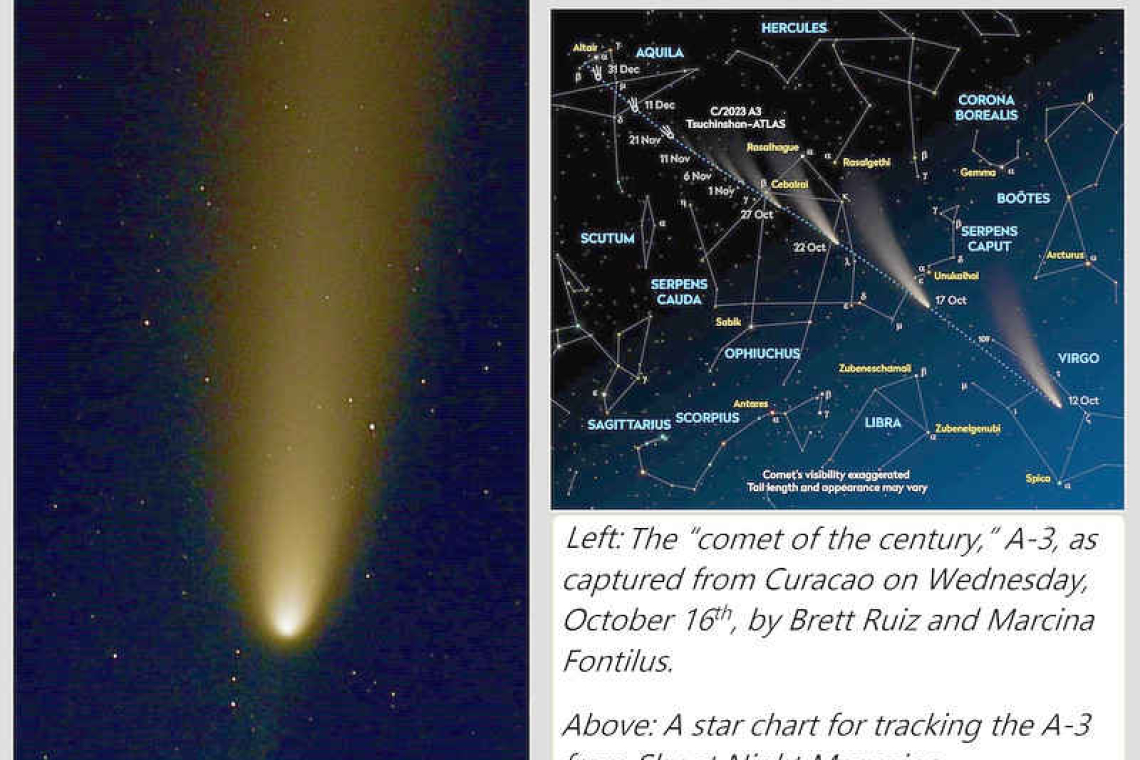~ St. Maarten’s Backyard Astronomy for October 25-27 ~
Sun rises at 6:09am
Sun sets at 5:42 pm
Lunar phase: 4th quarter, waning crescent
Moon rises at 1:23 am, Saturday
Moon sets at 2:26 pm, Saturday
This weekend, we have meteor showers and a comet to keep you looking up at the starry night sky. Although we have passed the peak of the Orionid Meteor Shower, don’t worry because it’s time now for the Taurid meteors. The North and South Taurids represent two different streams. They’re both active from now until about December 10. Both showers produce about five to ten meteors per hour and some of them are fireballs. The best time to watch for these shooting stars is around or after midnight. The official peak of the Taurids is November 5, but these two meteor showers ramble on for weeks and so it’s worth keeping a look up when you are out at night. Note: Taurid meteors tend to be slow-moving but can sometimes be very bright.
A-3, the so called “comet of the century,” is still visible in the evening sky, but it’s getting fainter each night. Look to the west after sunset. Find Venus, the “Evening Star” which lights up the western horizon as the sky darkens with sunset. It’s by far the brightest “star” in our sky, so it’s pretty hard to miss! From Venus, look directly up and just a bit to the right. People have been snapping pictures of this comet all over the world! We were given one particularly awesome image to share with you by our own Brett Ruiz of Curaçao, who, along with Marcina Fontilus, took this photo last week.
While looking up at the comet, you could use a good pair of binoculars or even your smartphone camera. These tools may provide you more visual details – although you can see the comet with its impressive tail without any optical aids at all. You should try to notice the coma, or the bright head of the comet, as well as the long dust tail – and a second tail may be visible which is the ionized tail.
Meanwhile, you can also scope out the planet scene this weekend: Saturn is up, high in the southern sky as soon as the sky goes dark. Jupiter rises up by 11:00pm, still located between the horns of Taurus the Bull. Mars rises up from the eastern horizon by about 11:30.
Thank you for keeping up with the Night Sky articles, backyard (or beach) astronomy designed for St. Maarten sky viewing. FYI: If you are out later on in the week, note that each star rises about four minutes earlier each day than written here, and the moon rises 50 minutes later. Night Sky is researched and compiled by Lisa Davis-Burnett. Earthsky.org is a key resource for information and images. Questions or comments? Email This email address is being protected from spambots. You need JavaScript enabled to view it.







